Global attitudes towards mental health are evolving, yet stigma remains a significant challenge. Awareness and education initiatives are crucial for fostering understanding and support. Countries like Canada and Australia are implementing campaigns to reduce stigma and enhance mental health literacy. However, disparities in attitudes persist globally, influenced by cultural and social factors.
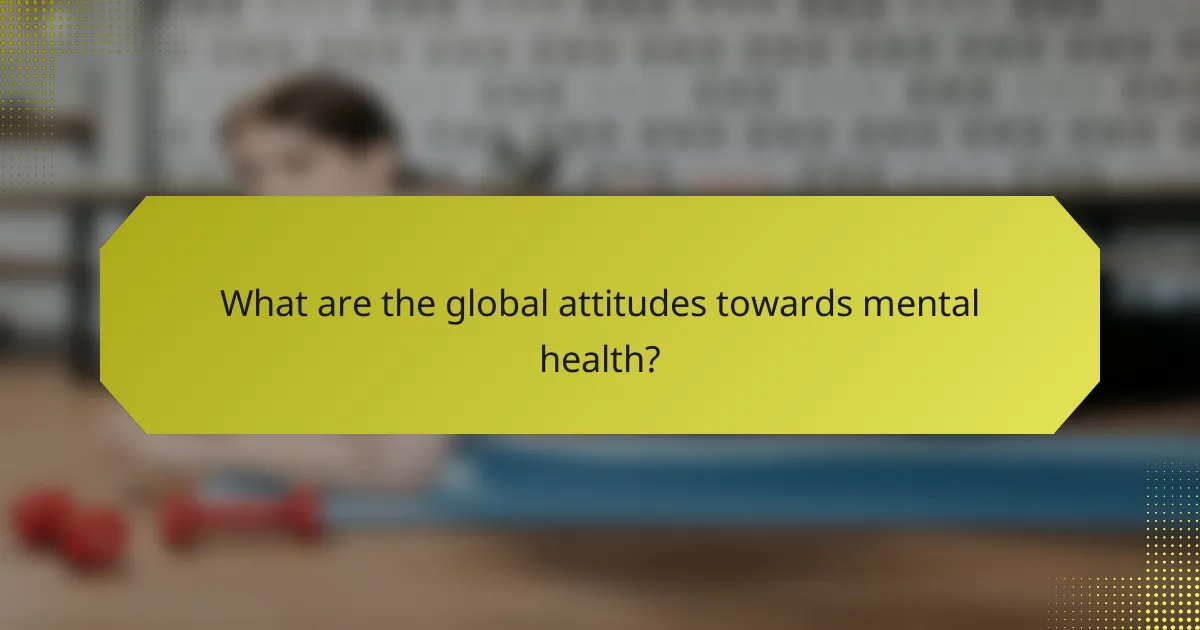
What are the global attitudes towards mental health?
Global attitudes towards mental health are increasingly shifting towards greater awareness and acceptance. Stigma remains a significant barrier, but educational initiatives are promoting understanding and support. For instance, countries like Canada and Australia have implemented national campaigns to reduce stigma and improve mental health literacy. Research shows that public awareness campaigns can lead to a 20% increase in positive attitudes towards mental health. Despite progress, disparities in attitudes persist globally, influenced by cultural, social, and economic factors.
How do cultural perceptions shape mental health stigma?
Cultural perceptions significantly influence mental health stigma, often leading to discrimination and misunderstanding. Societal beliefs shape how individuals view mental health issues, impacting awareness and education initiatives. For instance, in collectivist cultures, mental health may be seen as a family issue, resulting in reluctance to seek help. Conversely, individualistic societies may promote open discussions but still harbor stigma. Education initiatives that address these cultural nuances can reduce stigma and improve mental health outcomes globally.
What are the common misconceptions about mental health?
Common misconceptions about mental health include the belief that mental illnesses are a sign of weakness, that they are not real medical conditions, and that individuals can simply “snap out of it.” Many also think therapy is only for severe cases, while in reality, it can benefit anyone. Stigma persists globally, impacting awareness and education initiatives aimed at improving mental health understanding.

What are the universal attributes of mental health awareness?
Mental health awareness universally emphasizes reducing stigma, promoting education, and fostering open conversations. These attributes are essential for improving societal attitudes towards mental health. Awareness initiatives focus on informing communities about mental health issues, encouraging empathy, and supporting individuals affected by mental health challenges. Education plays a critical role in equipping people with knowledge to recognize signs of mental health conditions and seek help. Globally, the movement aims to create inclusive environments where mental health is prioritized and understood.
How does education influence mental health awareness?
Education significantly enhances mental health awareness by reducing stigma and promoting understanding. Initiatives like school-based programs foster open discussions, leading to increased empathy and support for mental health issues. Studies show that educated individuals are more likely to seek help and advocate for mental health resources, reflecting a shift in global attitudes. As a result, education serves as a vital tool in creating a more informed society that prioritizes mental well-being.
What role do social media platforms play in mental health education?
Social media platforms significantly enhance mental health education by increasing awareness and reducing stigma. These platforms facilitate access to resources, connect users with mental health professionals, and create supportive communities. For instance, campaigns on platforms like Instagram and Twitter promote mental health literacy and provide information on coping strategies. As a result, users gain insights into mental health issues, fostering a culture of openness. Studies show that social media can positively influence attitudes towards mental health, contributing to ongoing education initiatives worldwide.
Which campaigns have effectively raised awareness?
Several campaigns have effectively raised awareness about mental health. Notable examples include the “It’s Okay to Talk” initiative, which encourages open discussions, and the “Mental Health Awareness Month” campaign that promotes education and resources. These initiatives have significantly reduced stigma and increased public understanding. Research shows that such awareness campaigns can lead to a 20% increase in help-seeking behavior among individuals experiencing mental health issues.
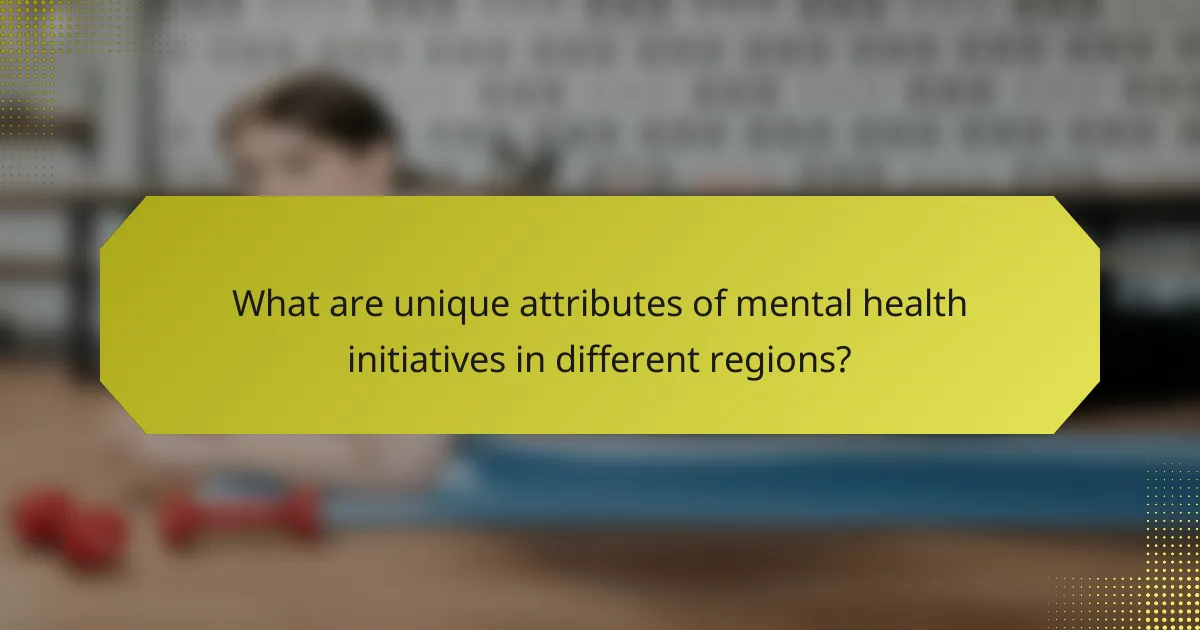
What are unique attributes of mental health initiatives in different regions?
Unique attributes of mental health initiatives vary significantly across regions, influenced by cultural attitudes and societal norms. For example, in Scandinavian countries, there is a strong focus on destigmatization and community support, fostering open discussions about mental health. In contrast, some Asian regions may prioritize family involvement in mental health care, reflecting collective cultural values. Additionally, access to mental health resources can differ; Western countries often have more robust healthcare systems compared to developing nations, where initiatives may rely heavily on non-governmental organizations. These variations highlight how local contexts shape mental health initiatives globally.
How do governmental policies impact mental health education?
Governmental policies significantly shape mental health education by promoting awareness and reducing stigma. Policies can allocate funding for educational initiatives, establish training programs, and set standards for mental health curricula. For instance, countries with comprehensive mental health policies often see improved public understanding and acceptance of mental health issues. As a result, these policies foster environments that support mental well-being and encourage individuals to seek help without fear of discrimination.
What innovative approaches are being used in schools?
Innovative approaches in schools include integrating mental health education into the curriculum, promoting awareness campaigns, and implementing peer support programs. These initiatives aim to reduce stigma, enhance understanding, and foster a supportive environment for students. For example, schools are adopting mindfulness practices and social-emotional learning to improve students’ mental well-being. As a result, these strategies help cultivate a culture of openness around mental health issues.
What are examples of successful mental health programs?
Successful mental health programs include initiatives that reduce stigma, promote awareness, and enhance education. Examples are the “Time to Change” campaign in the UK, which encourages conversations about mental health, and the “Mental Health First Aid” training in various countries that equips individuals with skills to support others. These programs demonstrate effective community engagement and education strategies, fostering a more supportive environment for mental health discussions.
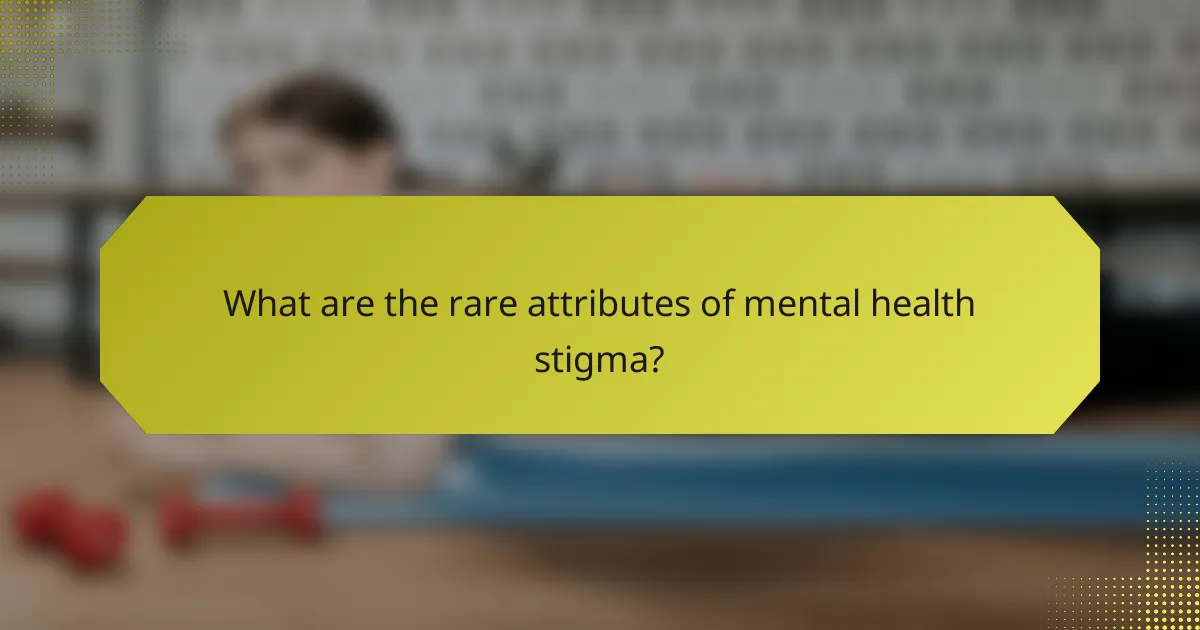
What are the rare attributes of mental health stigma?
The rare attributes of mental health stigma include cultural perceptions, generational differences, and intersectionality. Cultural perceptions vary significantly, influencing stigma levels across regions. Generational differences reveal that younger populations often exhibit more progressive attitudes. Intersectionality highlights how overlapping identities can compound stigma experiences, making them unique for individuals.
What are the effects of stigma on help-seeking behavior?
Stigma significantly hinders help-seeking behavior in individuals facing mental health challenges. Fear of judgment and social exclusion often prevents people from seeking necessary support. Research indicates that 30% of individuals with mental health issues avoid treatment due to stigma (Corrigan, 2004). This avoidance can lead to worsened mental health outcomes and increased societal costs. Education initiatives aimed at reducing stigma are vital for encouraging open discussions and promoting help-seeking behaviors.
How does stigma vary between different demographic groups?
Stigma surrounding mental health varies significantly among demographic groups. Cultural beliefs, socioeconomic status, and education level influence perceptions and attitudes towards mental health issues. For example, research indicates that younger individuals tend to exhibit more progressive views, while older generations may hold more traditional beliefs. Additionally, marginalized communities often face heightened stigma due to limited access to mental health resources and societal discrimination, impacting their willingness to seek help. Education initiatives targeting these groups can foster awareness and reduce stigma, leading to improved mental health outcomes.
What are the long-term impacts of stigma on mental health?
Stigma has long-term negative impacts on mental health, leading to isolation, reduced access to care, and worsening symptoms. Individuals facing stigma often experience increased anxiety and depression, which can hinder recovery. Studies indicate that stigma can lower self-esteem and deter individuals from seeking help, perpetuating a cycle of mental health decline. Awareness and education initiatives are crucial in combating stigma, promoting understanding, and improving mental health outcomes.
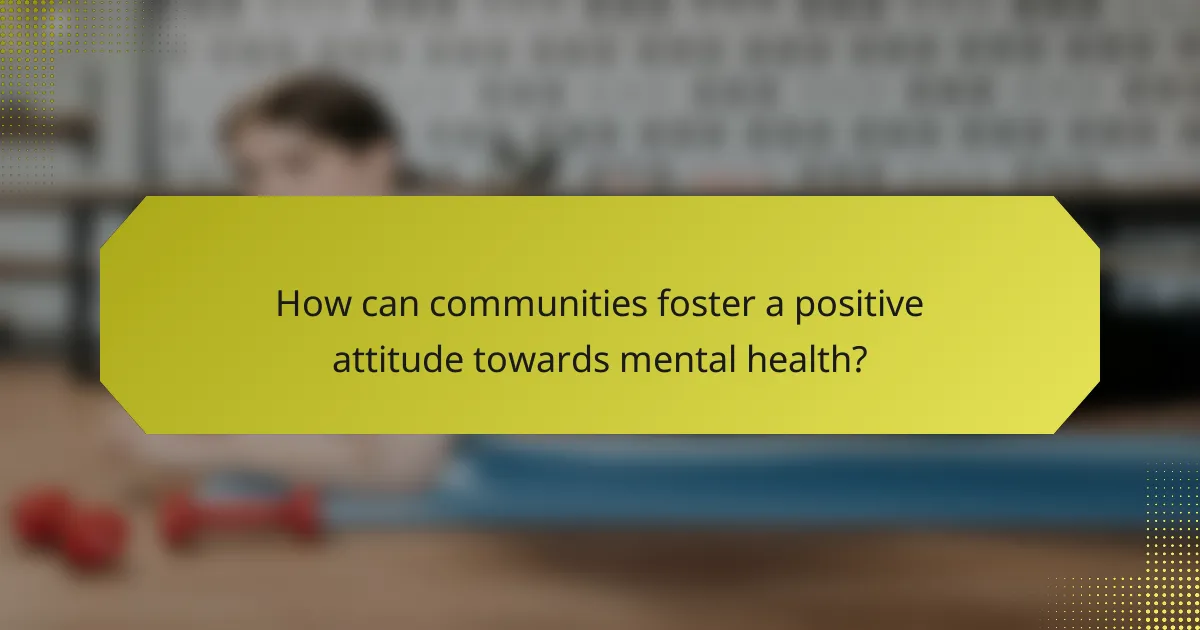
How can communities foster a positive attitude towards mental health?
Communities can foster a positive attitude towards mental health through awareness campaigns, education programs, and supportive environments. These initiatives help reduce stigma and encourage open dialogue. For example, community workshops that focus on mental health literacy can empower individuals to seek help. Additionally, creating safe spaces for discussion can promote understanding and acceptance. As a result, communities become more inclusive and supportive of mental health needs.
What best practices can organizations implement to reduce stigma?
Organizations can reduce stigma by fostering open conversations, providing mental health education, and promoting supportive environments. Training staff on mental health awareness is crucial. Encouraging peer support programs helps individuals share experiences, reducing feelings of isolation. Public campaigns that highlight positive stories can shift perceptions and challenge stereotypes. Establishing clear policies against discrimination fosters a culture of inclusivity.
What are the most effective strategies for education initiatives?
Education initiatives for mental health must prioritize awareness, destigmatization, and community engagement. Effective strategies include integrating mental health education into school curricula, promoting peer support programs, and utilizing social media campaigns to spread awareness. Research shows that early education reduces stigma and fosters understanding. Collaborating with mental health professionals enhances program credibility and impact. Engaging families and communities creates a supportive environment that reinforces learning.
How can individuals contribute to changing perceptions?
Individuals can contribute to changing perceptions by promoting open conversations about mental health. Engaging in discussions helps reduce stigma and fosters understanding. Sharing personal experiences can humanize mental health challenges and encourage empathy. Participating in community awareness campaigns educates others, highlighting the importance of mental wellness. Supporting mental health organizations amplifies their initiatives, furthering the reach of education and awareness efforts.
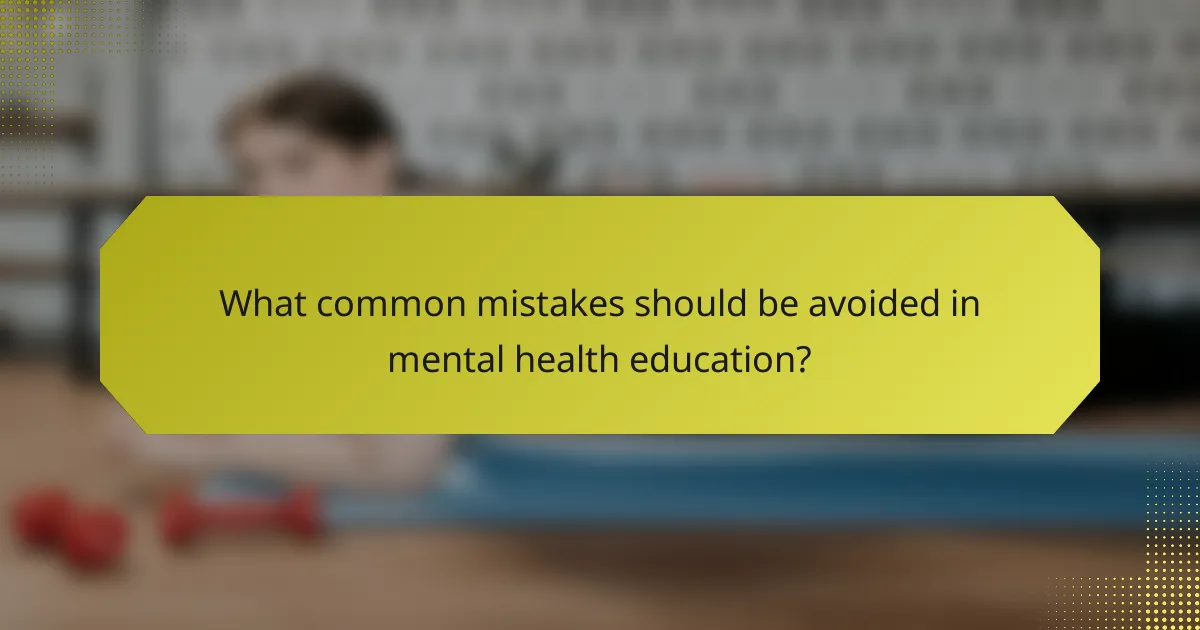
What common mistakes should be avoided in mental health education?
Avoiding common mistakes in mental health education is essential for effective communication and awareness. Key mistakes include perpetuating stigma, oversimplifying complex issues, neglecting cultural differences, and failing to engage with lived experiences.
Stigmatizing language can alienate individuals seeking help. Oversimplification undermines the complexity of mental health conditions, while neglecting cultural nuances can lead to misunderstandings. Engaging with individuals who have lived experiences enriches education and fosters empathy.
Addressing these mistakes enhances mental health education and promotes a supportive environment.
How can misinformation be effectively countered?
Misinformation can be effectively countered through education, critical thinking, and community engagement. Promoting mental health awareness reduces stigma and fosters informed discussions. Initiatives like workshops and campaigns can enhance understanding, enabling individuals to identify and challenge false narratives. Collaborative efforts among organizations can amplify these initiatives, creating a unified front against misinformation.
What are the challenges in implementing mental health programs?
Implementing mental health programs faces significant challenges, including stigma, lack of awareness, and insufficient funding. Stigma often prevents individuals from seeking help, while limited awareness hampers program outreach. Additionally, inadequate funding restricts resources for effective initiatives. Education initiatives can mitigate these issues by promoting understanding and acceptance of mental health.
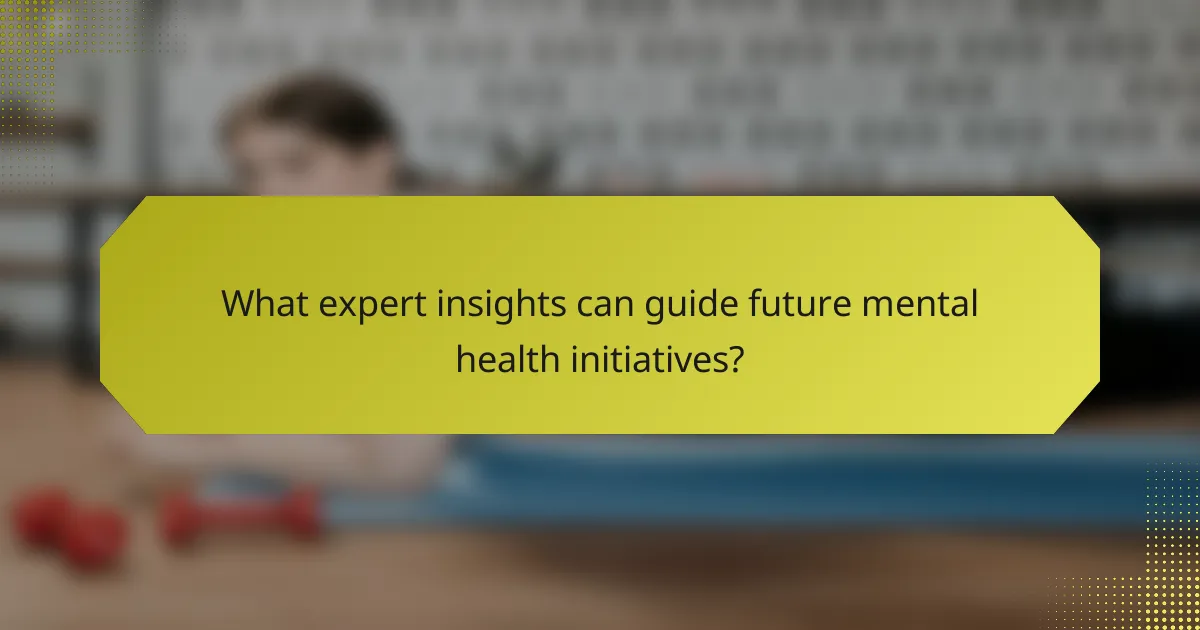
What expert insights can guide future mental health initiatives?
Expert insights can drive effective mental health initiatives by emphasizing stigma reduction, enhancing awareness, and improving education. Research shows that integrating community-based programs fosters understanding and acceptance. For instance, campaigns that highlight personal stories reduce stigma significantly, encouraging open conversations. Additionally, training educators in mental health literacy equips them to support students better, creating a more informed environment. As a result, these strategies contribute to a more supportive society, ultimately benefiting mental health outcomes globally.
How can data-driven approaches enhance awareness campaigns?
Data-driven approaches can significantly enhance awareness campaigns by providing targeted insights into public attitudes towards mental health. These insights help identify stigma levels and gaps in education initiatives, allowing for more effective messaging. For instance, analytics can reveal demographic differences in mental health perceptions, enabling campaigns to tailor content to specific audiences. Additionally, data can track campaign effectiveness in real-time, facilitating adjustments that improve outreach and engagement. As a result, campaigns become more impactful, fostering understanding and reducing stigma surrounding mental health issues.
What role do partnerships play in mental health advocacy?
Partnerships are crucial in mental health advocacy as they enhance awareness, reduce stigma, and promote education. Collaborative efforts among organizations, governments, and communities create a unified approach, amplifying the impact of mental health initiatives. For instance, partnerships can lead to shared resources, enabling broader outreach and innovative programs. As a result, they foster a supportive environment that encourages open discussions about mental health, ultimately improving public attitudes and understanding.


